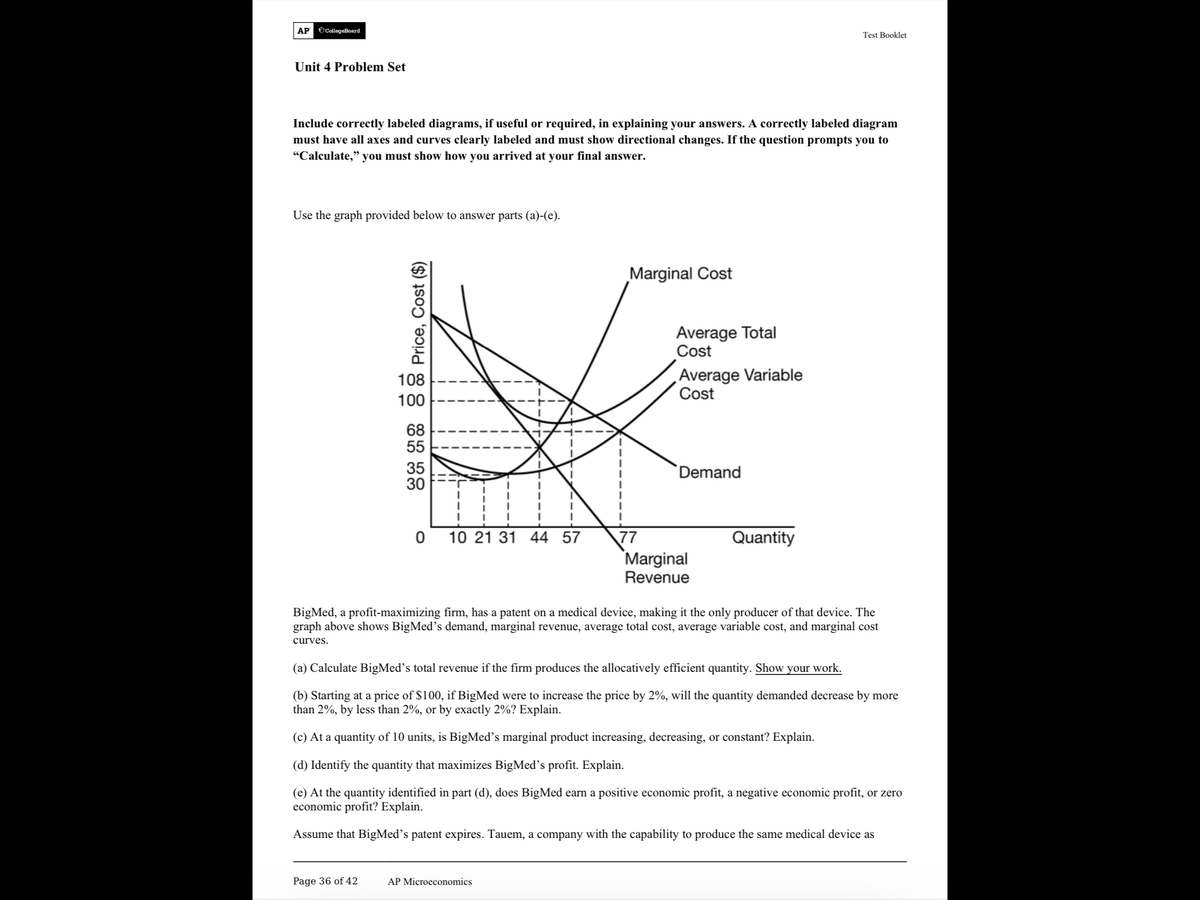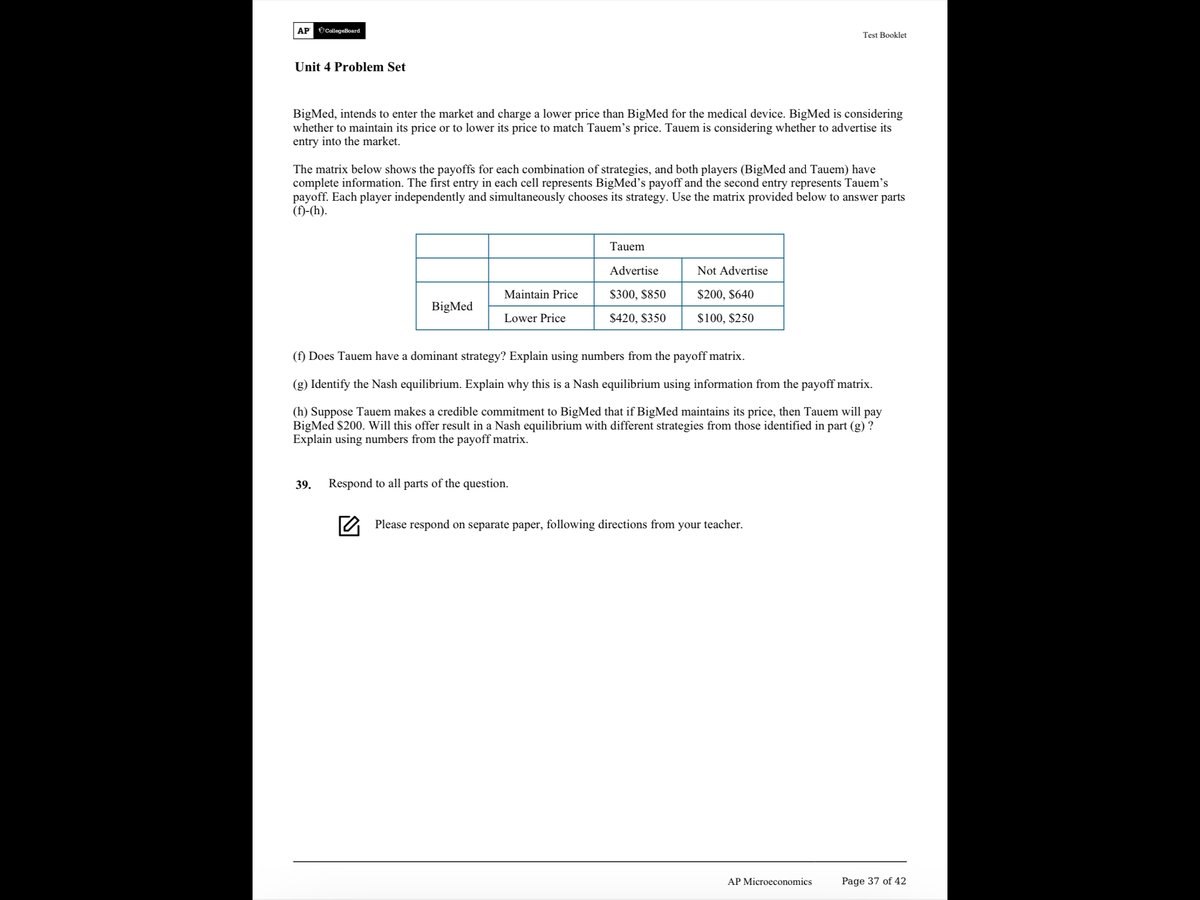Unit 4 Problem Set BigMed, intends to enter the market and charge a lower price than BigMed for the medical device. BigMed is considering whether to maintain its price or to lower its price to match Tauem's price. Tauem is considering whether to advertise its entry into the market. The matrix below shows the payoffs for each combination of strategies, and both players (BigMed and Tauem) have complete information. The first entry in each cell represents BigMed's payoff and the second entry represents Tauem's payoff. Each player independently and simultaneously chooses its strategy. Use the matrix provided below to answer parts (n-(h). Tauem Advertise Not Advertise Maintain Price $300, S850 $200, $640 BigMed S100, $250 Lower Price $420, $350 (1) Does Tauem have a dominant strategy? Explain using numbers from the payoff matrix. (g) Identify the Nash equilibrium. Explain why this is a Nash equilibrium using information from the payoff matrix. (h) Suppose Tauem makes a credible commitment to BigMed that if BigMed maintains its price, then Tauem will pay BigMed S200. Will this offer result in a Nash equilibrium with different strategies from those identified in part (g) ? Explain using numbers from the payoff matrix. 39. Respond to all parts of the question. Please respond on separate paper, following directions from your teacher.
Unit 4 Problem Set BigMed, intends to enter the market and charge a lower price than BigMed for the medical device. BigMed is considering whether to maintain its price or to lower its price to match Tauem's price. Tauem is considering whether to advertise its entry into the market. The matrix below shows the payoffs for each combination of strategies, and both players (BigMed and Tauem) have complete information. The first entry in each cell represents BigMed's payoff and the second entry represents Tauem's payoff. Each player independently and simultaneously chooses its strategy. Use the matrix provided below to answer parts (n-(h). Tauem Advertise Not Advertise Maintain Price $300, S850 $200, $640 BigMed S100, $250 Lower Price $420, $350 (1) Does Tauem have a dominant strategy? Explain using numbers from the payoff matrix. (g) Identify the Nash equilibrium. Explain why this is a Nash equilibrium using information from the payoff matrix. (h) Suppose Tauem makes a credible commitment to BigMed that if BigMed maintains its price, then Tauem will pay BigMed S200. Will this offer result in a Nash equilibrium with different strategies from those identified in part (g) ? Explain using numbers from the payoff matrix. 39. Respond to all parts of the question. Please respond on separate paper, following directions from your teacher.
Chapter1: What Is Economics
Section1.A: Using Graphs: A Review
Problem 3TY
Related questions
Question

Transcribed Image Text:AP
CollegeBoard
Test Booklet
Unit 4 Problem Set
Include correctly labeled diagrams, if useful or required, in explaining your answers. A correctly labeled diagram
must have all axes and curves clearly labeled and must show directional changes. If the question prompts you to
“Calculate," you must show how you arrived at your final answer.
Use the graph provided below to answer parts (a)-(e).
Marginal Cost
Average Total
Cost
Average Variable
Cost
108
100
55
Demand
0 10 21 31 44 57
77
Quantity
Marginal
Revenue
BigMed, a profit-maximizing firm, has a patent on a medical device, making it the only producer of that device. The
graph above shows BigMed's demand, marginal revenue, average total cost, average variable cost, and marginal cost
curves.
(a) Calculate BigMed's total revenue if the firm produces the allocatively efficient quantity. Show your work.
(b) Starting at a price of $100, if BigMed were to increase the price by 2%, will the quantity demanded decrease by more
than 2%, by less than 2%, or by exactly 2%? Explain.
(c) At a quantity of 10 units, is BigMed's marginal product increasing, decreasing, or constant? Explain.
(d) Identify the quantity that maximizes BigMed's profit. Explain.
(e) At the quantity identified in part (d), does BigMed earn a positive economic profit, a negative economic profit, or zero
economic profit? Explain.
Assume that BigMed's patent expires. Tauem, a company with the capability to produce the same medical device as
Page 36 of 42
AP Microeconomics
88 A3 88 Price, Cost ($)

Transcribed Image Text:AP
CollegeBoard
Test Booklet
Unit 4 Problem Set
BigMed, intends to enter the market and charge a lower price than BigMed for the medical device. BigMed is considering
whether to maintain its price or to lower its price to match Tauem's price. Tauem is considering whether to advertise its
entry into the market.
The matrix below shows the payoffs for each combination of strategies, and both players (BigMed and Tauem) have
complete information. The first entry in each cell represents BigMed's payoff and the second entry represents Tauem's
payoff. Each player independently and simultaneously chooses its strategy. Use the matrix provided below to answer parts
(f)-(h).
Tauem
Advertise
Not Advertise
Maintain Price
$300, $850
$200, $640
BigMed
Lower Price
$420, $350
$100, $250
(f) Does Tauem have a dominant strategy? Explain using numbers from the payoff matrix.
(g) Identify the Nash equilibrium. Explain why this is a Nash equilibrium using information from the payoff matrix.
(h) Suppose Tauem makes a credible commitment to BigMed that if BigMed maintains its price, then Tauem will pay
BigMed $200. Will this offer result in a Nash equilibrium with different strategies from those identified in part (g) ?
Explain using numbers from the payoff matrix.
39.
Respond to all parts of the question.
2 Please respond on separate paper, following directions from your teacher.
AP Microeconomics
Page 37 of 42
Expert Solution
This question has been solved!
Explore an expertly crafted, step-by-step solution for a thorough understanding of key concepts.
This is a popular solution!
Trending now
This is a popular solution!
Step by step
Solved in 2 steps with 1 images

Knowledge Booster
Learn more about
Need a deep-dive on the concept behind this application? Look no further. Learn more about this topic, economics and related others by exploring similar questions and additional content below.Recommended textbooks for you







